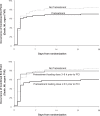Use of clopidogrel in the reduction of myocardial damage during percutaneous coronary intervention
- PMID: 19436675
- PMCID: PMC2672464
- DOI: 10.2147/vhrm.s4309
Use of clopidogrel in the reduction of myocardial damage during percutaneous coronary intervention
Abstract
It is estimated that approximately a quarter of patients undergoing coronary intervention may have significant post-procedural creatinine (CK)/creatinine kinase myocardial band (CK-MB) elevations and approximately half may have post-procedural troponin elevations. Current data suggest that periprocedural infarction is associated with short-, intermediate-, and long-term adverse outcomes, most notably mortality. This review examines the role of clopidogrel in decreasing periprocedural myonecrosis following percutaneous coronary intervention (PCI). Clopidogrel is an important pharmacologic agent used to reduce myocardial infarction post-coronary intervention as assessed directly by the evaluation of cardiac biomarkers and indirectly by the evaluation of short-term ischemic events. The optimal dose of clopidogrel is considered to be at least 300 mg given 6 to 15 hours prior to PCI but there is considerable evidence to suggest that a loading dose of 600 mg given 2 to 6 hours prior to PCI may be more efficacious in limiting post-coronary intervention events. The benefit obtained from clopidogrel appears independent of and incremental to that of other antiplatelet and antithrombotic agents used during and after coronary intervention.
Keywords: antiplatelet agents; clopidogrel; myocardial infarction; myonecrosis; percutaneous coronary intervention.
Figures









Similar articles
-
Point-of-care assessment of platelet reactivity after clopidogrel to predict myonecrosis in patients undergoing percutaneous coronary intervention.JACC Cardiovasc Interv. 2010 Mar;3(3):318-23. doi: 10.1016/j.jcin.2009.12.012. JACC Cardiovasc Interv. 2010. PMID: 20298992
-
Lack of efficacy of clopidogrel pre-treatment in the prevention of myocardial damage after elective stent implantation.J Am Coll Cardiol. 2004 Jul 7;44(1):20-4. doi: 10.1016/j.jacc.2004.02.056. J Am Coll Cardiol. 2004. PMID: 15234399 Clinical Trial.
-
The effects of aspirin and clopidogrel response on myonecrosis after percutaneous coronary intervention: a BRIEF-PCI (Brief Infusion of Intravenous Eptifibatide Following Successful Percutaneous Coronary Intervention) trial substudy.JACC Cardiovasc Interv. 2008 Dec;1(6):654-9. doi: 10.1016/j.jcin.2008.08.017. JACC Cardiovasc Interv. 2008. PMID: 19463380 Clinical Trial.
-
[Prevention of periprocedural myocardial damage in patients undergoing percutaneous coronary intervention].Ital Heart J Suppl. 2005 Sep;6(9):553-60. Ital Heart J Suppl. 2005. PMID: 16281714 Review. Italian.
-
Is periprocedural CK-MB a better indicator of prognosis after emergency and elective percutaneous coronary intervention compared with post-procedural cardiac troponins?Interact Cardiovasc Thorac Surg. 2013 Nov;17(5):867-71. doi: 10.1093/icvts/ivt303. Epub 2013 Jul 9. Interact Cardiovasc Thorac Surg. 2013. PMID: 23842761 Free PMC article. Review.
References
-
- Sheldon WC. Trends in cardiac catheterization laboratories in the United States. Catheter Cardiovasc Interv. 2001;53(1):40–45. - PubMed
-
- Bhatt DL, Topol EJ.Does creatinine kinase-MB elevation after percutaneous coronary intervention predict outcomes in 2005? Periprocedural cardiac enzyme elevation predicts adverse outcomes Circulation 20051126906–915.discussion 923. - PubMed
-
- Thygesen K, Alpert JS, White HD. Universal definition of myocardial infarction. J Am Coll Cardiol. 2007;50(22):2173–2195. - PubMed
-
- Brener SJ, Lytle BW, Schneider JP, et al. Association between CK-MB elevation after percutaneous or surgical revascularization and three-year mortality. J Am Coll Cardiol. 2002;40(11):1961–1967. - PubMed
-
- Mukherjee D, Oz M, Prager R, et al. Elective coronary revascularization, an iatrogenic form of acute coronary syndrome: how can clinicians reduce the risks? Am Heart J. 2004;148(3):371–377. - PubMed
Publication types
MeSH terms
Substances
LinkOut - more resources
Full Text Sources
Medical
Research Materials
Miscellaneous

